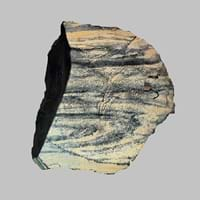Oil shale and Tuff
Definition
Definition
Oil Shale is a fine-grained sedimentary rock from which oil is extracted
Tuff is a type of rock made of volcanic ash ejected from a vent during a volcanic eruption
History
Origin
Unknown
Italy
Discoverer
Unknown
Unknown
Etymology
From Old English scealu in its base sense of thing that divides or separate
From a Latin word tophous then in Italian tufo and finally tuff
Class
Sedimentary Rocks
Igneous Rocks
Sub-Class
Durable Rock, Soft Rock
Durable Rock, Medium Hardness Rock
Family
Group
Not Applicable
Volcanic
Other Categories
Fine Grained Rock, Opaque Rock
Fine Grained Rock, Opaque Rock
Texture
Texture
Splintery
Clastic, Pyroclastic
Color
Black, Brown, Buff, Green, Grey, Red, Yellow
Brown, Grey, Yellow
Maintenance
Less
More
Durability
Durable
Durable
Water Resistant
Yes
Yes
Scratch Resistant
No
Yes
Stain Resistant
Yes
No
Wind Resistant
No
No
Acid Resistant
No
No
Appearance
Muddy
Dull, Vesicular and Foilated
Uses
Architecture
Interior Uses
Not Yet Used
Decorative Aggregates, Entryways, Flooring, Homes, Interior Decoration
Exterior Uses
Not Yet Used
As Building Stone, As Facing Stone, Garden Decoration, Office Buildings, Paving Stone
Other Architectural Uses
Not Yet Used
Curbing
Industry
Construction Industry
Cement Manufacture, Construction Aggregate, for Road Aggregate, Serves as an Oil and Gas Reservoir rock
Building houses or walls, Construction Aggregate
Medical Industry
Not Yet Used
Not Yet Used
Antiquity Uses
Artifacts
Artifacts, Monuments, Sculpture, Small Figurines
Other Uses
Commercial Uses
An Oil and Gas Reservoir
Creating Artwork
Types
Types
Carbonate-rich Shale, Siliceous Shale and Cannel Shale
Welded tuff, Rhyolitic tuff, Basaltic tuff, Trachyte tuff, Andesitic tuff and Ignimbrite.
Features
Easily splits into thin plates, Generally rough to touch, Is one of the oldest rock, Very fine grained rock
Always found as volcanic pipes over deep continental crust
Archaeological Significance
Monuments
Not Yet Used
Used
Famous Monuments
Not Applicable
Easter Island in the Polynesian Triangle, Pacific Ocean
Sculpture
Not Yet Used
Used
Famous Sculptures
Not Applicable
Data Not Available
Pictographs
Not Used
Used
Petroglyphs
Not Used
Used
Figurines
Not Yet Used
Used
Fossils
Present
Absent
Formation
Formation
Oil Shale forms on the beds of seas and lakes and its formation starts with the organic debris settling and accumulating at the bottom of a lake or sea which are then transformed into rock with the help of high temperature and pressure.
Tuff is formed when large masses of ash and sand which are mixed with hot gases are ejected by a volcano and avalanche rapidly down its slopes.
Composition
Mineral Content
Albite, Biotite, Calcite, Chert, Chlorite, Dolomite, Hematite, Micas, Muscovite or Illite, Pyrite, Quartz, Silica, Sulfides
Calcite, Chlorite
Compound Content
Ca, Fe, Mg, Silicon Dioxide, Sodium
Hydrogen Sulfide, Sulfur Dioxide
Transformation
Metamorphism
No
Yes
Types of Metamorphism
Not Applicable
Burial Metamorphism, Cataclastic Metamorphism, Contact Metamorphism, Hydrothermal Metamorphism, Impact Metamorphism, Regional Metamorphism
Weathering
Yes
Yes
Types of Weathering
Biological Weathering, Chemical Weathering, Mechanical Weathering
Biological Weathering, Chemical Weathering, Mechanical Weathering
Erosion
Yes
Yes
Types of Erosion
Chemical Erosion, Sea Erosion, Water Erosion
Chemical Erosion, Coastal Erosion, Glacier Erosion, Sea Erosion, Water Erosion, Wind Erosion
Properties
Physical Properties
Hardness
2-3
4-6
Grain Size
Very fine-grained
Fine Grained
Fracture
Not Available
Uneven
Streak
White
White
Porosity
Highly Porous
Highly Porous
Luster
Dull
Vitreous to Dull
Compressive Strength
Not Available
243.80 N/mm2
5
Cleavage
Slaty
Not Available
Toughness
2.6
Not Available
Specific Gravity
2.2-2.8
2.73
Transparency
Opaque
Opaque
Density
2.4-2.8 g/cm3
1-1.8 g/cm3
Thermal Properties
Specific Heat Capacity
0.39 kJ/Kg K
23
0.20 kJ/Kg K
25
Resistance
Heat Resistant, Impact Resistant
Heat Resistant, Impact Resistant, Pressure Resistant, Wear Resistant
Reserves
Deposits in Eastern Continents
Asia
Bangladesh, China, India, Israel, Jordan, Russia, Syria, Thailand, Turkey
Afghanistan, Armenia, Azerbaijan, Burma, Cambodia, China, India, Indonesia, Iran, Japan, Malaysia, Mongolia, Nepal, North Korea, Pakistan, Saudi Arabia, Syria, Taiwan, Thailand, Turkey, Vietnam, Yemen
Africa
Ethiopia, Kenya, Morocco, South Africa, Tanzania
Cameroon, Cape Verde, Eritrea, Ethiopia, Kenya, Libya, Madagascar, Nigeria, Rwanda, South Africa, Sudan, Uganda
Europe
Austria, France, Germany, Greece, Italy, Romania, Scotland, Spain, Sweden, Switzerland
France, Georgia, Germany, Greece, Iceland, Italy, Netherlands, Poland, Portugal, Spain, United Kingdom
Others
Greenland, Not Yet Found
Antarctica, Hawaii Islands
Deposits in Western Continents
North America
Canada, USA
Canada, Costa Rica, Panama, USA
South America
Bolivia, Brazil, Chile, Colombia, Ecuador, Peru, Venezuela
Argentina, Bolivia, Brazil, Chile, Ecuador, Paraguay
Deposits in Oceania Continent
Australia
New South Wales, New Zealand, Queensland, Victoria, Western Australia
Central Australia, Western Australia
All about Oil shale and Tuff Properties
Know all about Oil shale and Tuff properties here. All properties of rocks are important as they define the type of rock and its application. Oil shale belongs to Sedimentary Rocks while Tuff belongs to Igneous Rocks.Texture of Oil shale is Splintery whereas that of Tuff is Clastic, Pyroclastic. Oil shale appears Muddy and Tuff appears Dull, Vesicular and Foilated. The luster of Oil shale is dull while that of Tuff is vitreous to dull. Oil shale and Tuff are available in black, brown, buff, green, grey, red, yellow colors. The commercial uses of Oil shale are an oil and gas reservoir and that of Tuff are creating artwork.
|
||
|
||
|










